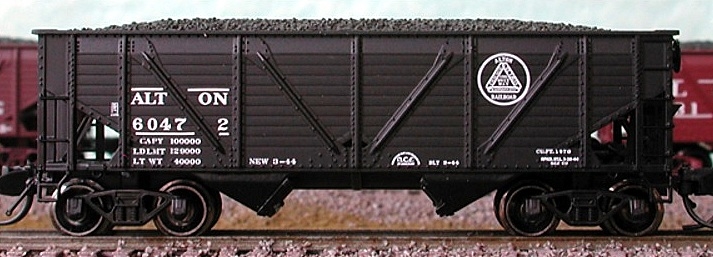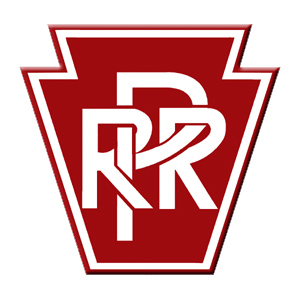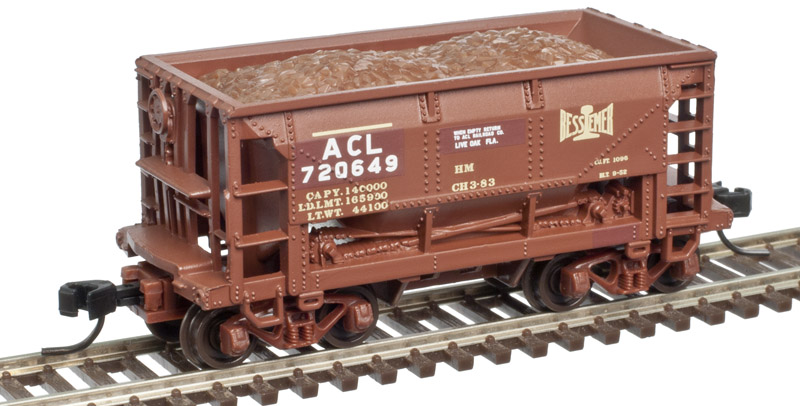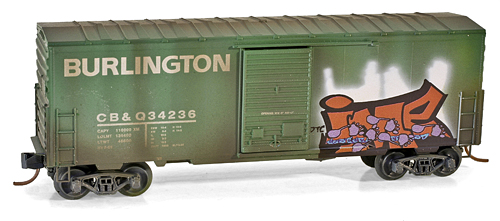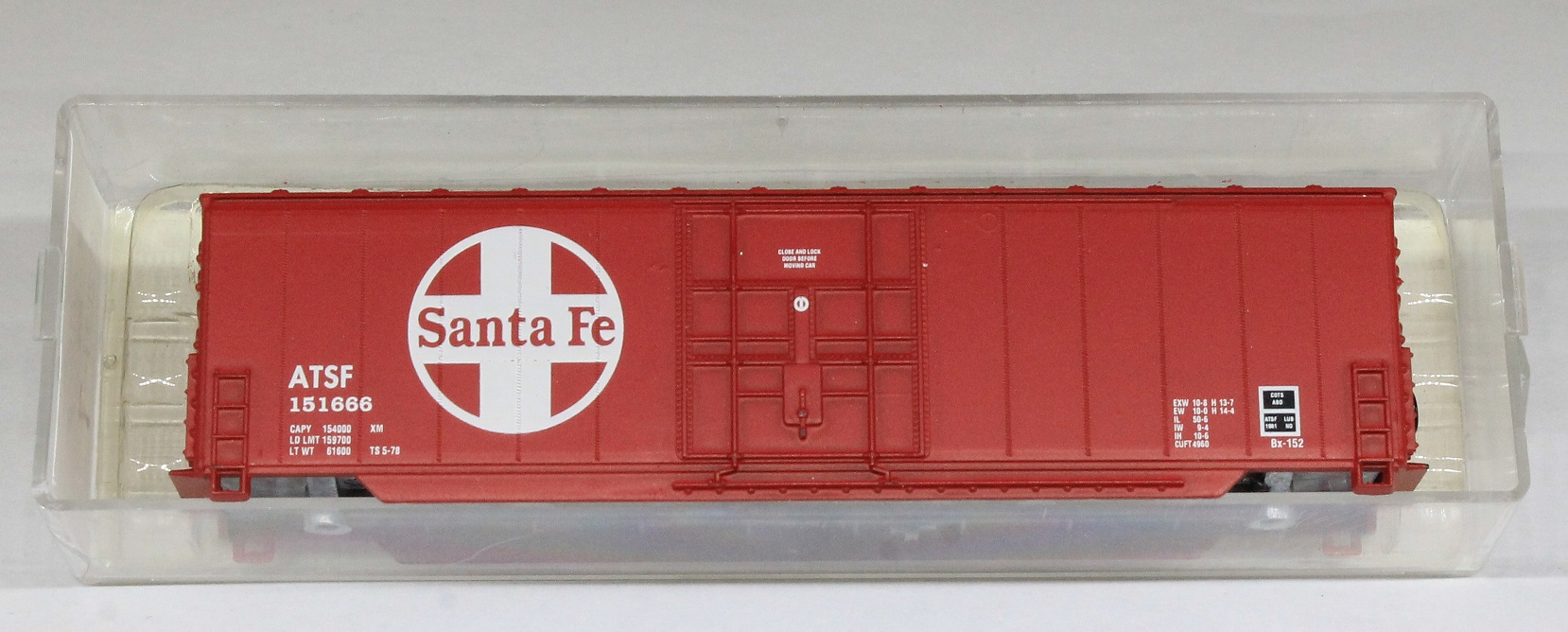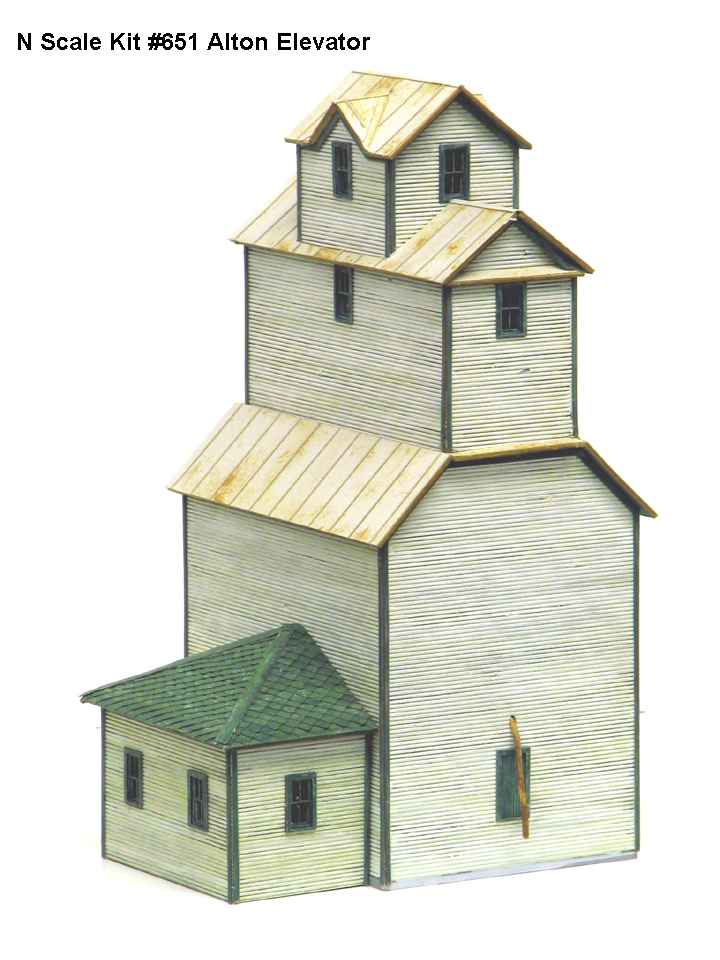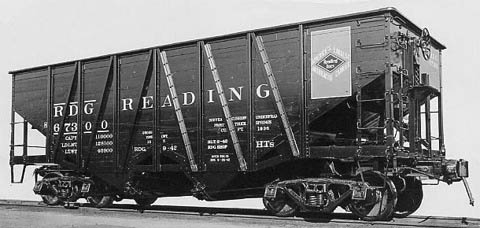Specific Item Information: The Alton Railroad received their 750 War Emergency Composite Hoppers from American Car & Foundry in 1944. The 1,000 mile Alton system linked Chicago with St. Louis and Kansas City. The company was established in 1931 under the control of the B&O to take over the assets of the Chicago & Alton. B&O sold their stake in the Alton in 1945 to the Gulf Mobile & Ohio. The Alton Railroad was merged into the GM&O two years later
Model Information: Bluford Shops is proud to announce our third new body style in N scale for July 2017. This time we have 2-Bay War Emergency Composite Hoppers. These are the predecessors of the Rebuilt War Emergency Hoppers we announced last month. These cars were built during the Second World War with wood siding and slope sheets at the direction of the War Production Board in hopes of saving as much steel as possible for the war effort. This was especially the case with hoppers that were usually built with copper-bearing steel to resist corrosion. The car sides were built with the Pratt truss design using a combination of vertical and diagonal ribs. A majority were later rebuilt with steel replacing the wood components but some composite cars remained in service into the 1970s.
These ready-to-run cars feature: die cast slope sheet-hopper bay-center sill assembly; injection molded plastic sides, ends, and hopper doors; fully molded brake tank, valve and air lines; body mounted brake hose detail; load; body mounted magnetically operating knuckle couplers; close coupling; and Fox Valley Models metal wheels.
All road names will be available in multiple road numbers. For instance, order a single, a 2-pack and a 3-pack to get all six road numbers on a run. (Some road names will be available in just three road numbers.)
These ready-to-run cars feature: die cast slope sheet-hopper bay-center sill assembly; injection molded plastic sides, ends, and hopper doors; fully molded brake tank, valve and air lines; body mounted brake hose detail; load; body mounted magnetically operating knuckle couplers; close coupling; and Fox Valley Models metal wheels.
All road names will be available in multiple road numbers. For instance, order a single, a 2-pack and a 3-pack to get all six road numbers on a run. (Some road names will be available in just three road numbers.)
Prototype History: The story of these 2-Bay War Emergency Hoppers begins in 1942 when the War Production Board directed car builders to substitute wood for steel wherever possible in car superstructures. The familiar 2-Bay War Emergency Composite Hopper was a result of this directive. Those cars had wooden side sheets and end slope sheets (although the middle slope sheets remained steel.)
The wood siding was thicker than comparable steel sheeting and this reduced the capacity of the cars. While you could build ten composite cars with the steel from nine all-steel cars, it took more composite cars to move the same amount of coal. This combined with the more frequent repairs required by the composite cars soured the War Production Board on the design.
During 1944, the directive was set aside and cars that were on order were delivered with the familiar diagonal bracing but with all steel construction. After the war, as composite cars came due for serious maintenance, the wood side and slope sheets were replaced with steel. A large majority of the composite cars were rebuilt in this manner sometime during the 1950s.
From Bluford Shops
The wood siding was thicker than comparable steel sheeting and this reduced the capacity of the cars. While you could build ten composite cars with the steel from nine all-steel cars, it took more composite cars to move the same amount of coal. This combined with the more frequent repairs required by the composite cars soured the War Production Board on the design.
During 1944, the directive was set aside and cars that were on order were delivered with the familiar diagonal bracing but with all steel construction. After the war, as composite cars came due for serious maintenance, the wood side and slope sheets were replaced with steel. A large majority of the composite cars were rebuilt in this manner sometime during the 1950s.
From Bluford Shops
Road Name History: 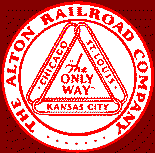 The Alton was established in 1931 as a subsidiary of Baltimore & Ohio to takeover the Chicago & Alton Railroad which B&O had picked up at a foreclosure sale in 1929. Alton was a 1,028 mile system running from Chicago to St. Louis, much of it on parallel routes, one via Bloomington and Springfield, the other via Peoria. The parallel routes met at Alton, Illinois, a Mississippi River port 20 miles north of St. Louis. Another line ran from Springfield west to Kansas City, plus branches. Alton had the second shortest route from Chicago to Kansas City (only Santa Fe was shorter.) At its founding, Alton had 292 locomotives, 232 passenger cars and more than 13,000 freight cars. For most of its history, Alton was operated in close cooperation with B&O but that changed in 1943 when Alton was untangled from B&O in the hope of selling it. In 1945, Gulf Mobile & Ohio (itself the result of a merger just five years before) bought the Alton for $1.2 million. At the time, GM&O only ran as far north as St. Louis so the addition of Alton transformed them into a Great Lakes-to-the-Gulf system. The two systems were merged in 1947. The expanded GM&O adopted Alton’s red and maroon passenger colors and “the Alton Route” was applied to many GM&O steam locomotive tenders and some diesel flanks. Today, the St. Louis – Chicago line is part of Union Pacific by way of Illinois Central Gulf , Chicago Missouri & Western and Southern Pacific. The Springfield – Kansas City line is part of Kansas City Southern by way of ICG, CM&W and Gateway Western. (Tex Courtesy of Bluford Shops)
The Alton was established in 1931 as a subsidiary of Baltimore & Ohio to takeover the Chicago & Alton Railroad which B&O had picked up at a foreclosure sale in 1929. Alton was a 1,028 mile system running from Chicago to St. Louis, much of it on parallel routes, one via Bloomington and Springfield, the other via Peoria. The parallel routes met at Alton, Illinois, a Mississippi River port 20 miles north of St. Louis. Another line ran from Springfield west to Kansas City, plus branches. Alton had the second shortest route from Chicago to Kansas City (only Santa Fe was shorter.) At its founding, Alton had 292 locomotives, 232 passenger cars and more than 13,000 freight cars. For most of its history, Alton was operated in close cooperation with B&O but that changed in 1943 when Alton was untangled from B&O in the hope of selling it. In 1945, Gulf Mobile & Ohio (itself the result of a merger just five years before) bought the Alton for $1.2 million. At the time, GM&O only ran as far north as St. Louis so the addition of Alton transformed them into a Great Lakes-to-the-Gulf system. The two systems were merged in 1947. The expanded GM&O adopted Alton’s red and maroon passenger colors and “the Alton Route” was applied to many GM&O steam locomotive tenders and some diesel flanks. Today, the St. Louis – Chicago line is part of Union Pacific by way of Illinois Central Gulf , Chicago Missouri & Western and Southern Pacific. The Springfield – Kansas City line is part of Kansas City Southern by way of ICG, CM&W and Gateway Western. (Tex Courtesy of Bluford Shops)

Brand/Importer Information: Bluford Shops began in 2007 as a side project of two model railroad industry veterans, Craig Ross and Steve Rodgers. They saw a gap between road names available on N scale locomotives but not available on cabooses. They commissioned special runs of Atlas cabooses in Atlantic Coast Line, Central of Georgia, Monon, Boston & Maine and Southern plus runs on Grand Trunk Western and Central Vermont on the MDC wooden cabooses. While these were in process, they began to develop their first all new tooling project, 86' Auto Parts Boxcars in double door and quad door editions in N scale. By January of 2008, Bluford Shops became a full time venture. Along with additional N scale freight cars and their own tooling for new cabooses, they have brought their own caboose line to HO scale. They also have their popular Cornfields in both HO and N. The future looks bright as they continue to develop new products for your railroad.
The town of Bluford in southern Illinois featured a small yard on Illinois Central's Edgewood Cutoff (currently part of CN.) The yard included a roundhouse, concrete coaling tower (which still stands) and large ice house. Reefer trains running between the Gulf Coast and Chicago were re-iced in Bluford. Things are more quiet now in Bluford with the remaining tracks in the yard used to stage hoppers for mines to the south and store covered hoppers. Intersecting the IC line in Bluford is Southern Railway's (currently NS) line between Louisville and St. Louis. Traffic on this single track line remains relatively heavy.
The town of Bluford in southern Illinois featured a small yard on Illinois Central's Edgewood Cutoff (currently part of CN.) The yard included a roundhouse, concrete coaling tower (which still stands) and large ice house. Reefer trains running between the Gulf Coast and Chicago were re-iced in Bluford. Things are more quiet now in Bluford with the remaining tracks in the yard used to stage hoppers for mines to the south and store covered hoppers. Intersecting the IC line in Bluford is Southern Railway's (currently NS) line between Louisville and St. Louis. Traffic on this single track line remains relatively heavy.
Item created by: gdm on 2017-07-19 19:25:59
If you see errors or missing data in this entry, please feel free to log in and edit it. Anyone with a Gmail account can log in instantly.
If you see errors or missing data in this entry, please feel free to log in and edit it. Anyone with a Gmail account can log in instantly.


